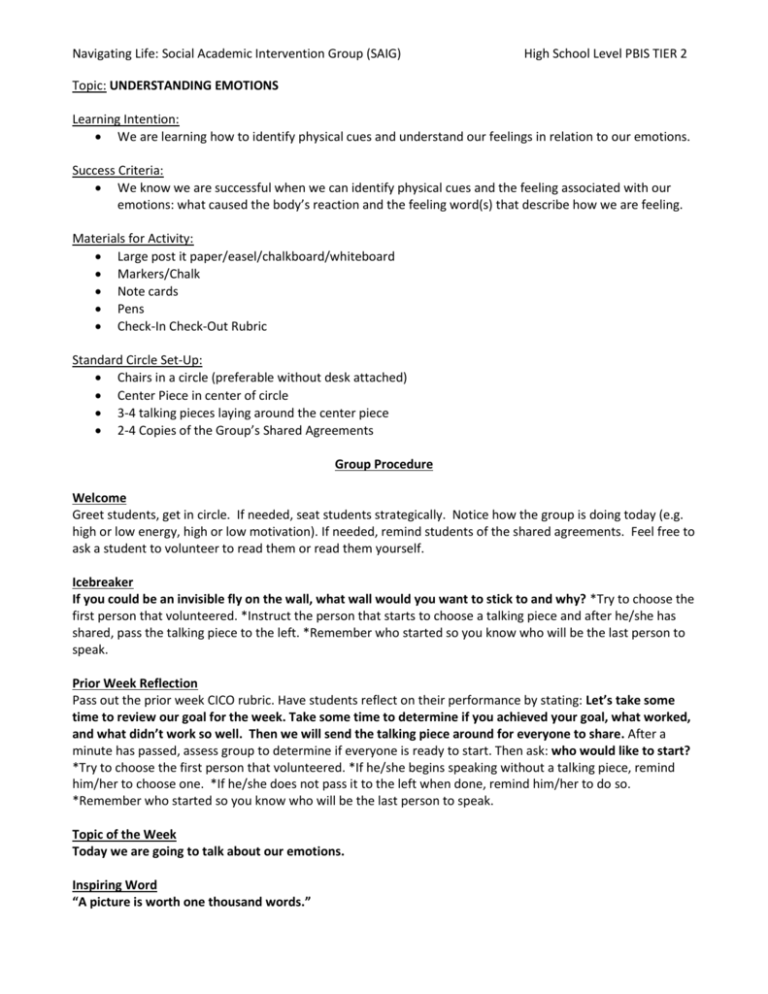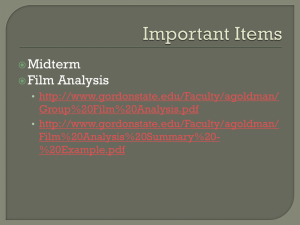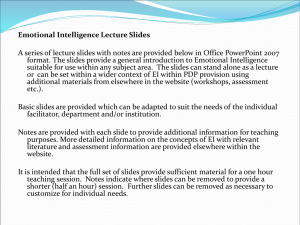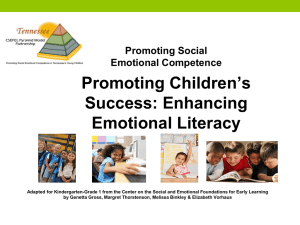Navigating Life: Social Academic Intervention Group (SAIG) High
advertisement

Navigating Life: Social Academic Intervention Group (SAIG) High School Level PBIS TIER 2 Topic: UNDERSTANDING EMOTIONS Learning Intention: We are learning how to identify physical cues and understand our feelings in relation to our emotions. Success Criteria: We know we are successful when we can identify physical cues and the feeling associated with our emotions: what caused the body’s reaction and the feeling word(s) that describe how we are feeling. Materials for Activity: Large post it paper/easel/chalkboard/whiteboard Markers/Chalk Note cards Pens Check-In Check-Out Rubric Standard Circle Set-Up: Chairs in a circle (preferable without desk attached) Center Piece in center of circle 3-4 talking pieces laying around the center piece 2-4 Copies of the Group’s Shared Agreements Group Procedure Welcome Greet students, get in circle. If needed, seat students strategically. Notice how the group is doing today (e.g. high or low energy, high or low motivation). If needed, remind students of the shared agreements. Feel free to ask a student to volunteer to read them or read them yourself. Icebreaker If you could be an invisible fly on the wall, what wall would you want to stick to and why? *Try to choose the first person that volunteered. *Instruct the person that starts to choose a talking piece and after he/she has shared, pass the talking piece to the left. *Remember who started so you know who will be the last person to speak. Prior Week Reflection Pass out the prior week CICO rubric. Have students reflect on their performance by stating: Let’s take some time to review our goal for the week. Take some time to determine if you achieved your goal, what worked, and what didn’t work so well. Then we will send the talking piece around for everyone to share. After a minute has passed, assess group to determine if everyone is ready to start. Then ask: who would like to start? *Try to choose the first person that volunteered. *If he/she begins speaking without a talking piece, remind him/her to choose one. *If he/she does not pass it to the left when done, remind him/her to do so. *Remember who started so you know who will be the last person to speak. Topic of the Week Today we are going to talk about our emotions. Inspiring Word “A picture is worth one thousand words.” Lesson Emotions can vary from small to big and some situations can make one person feel one way and another person feel totally different. Emotions can usually be identified by tuning in to what is going on in your body. These cues help you know how you are feeling. We are going to start today discussing the body cues or physical characteristics of feelings. For example, when I feel nervous, my palms start sweating or when I feel angry my cheeks get red and my chest feels tight. Let’s go around and share one or two physical characteristics or body cues that you feel. Circle Keeper keeps track of the physical characteristics. DO NOT record the feeling words now, you will record those later. You each identified some important body cues or physical characteristics that feelings evoke. Let’s imagine that you received a text saying negative things about you from a good friend. What body cues or physical characteristics would you notice? What happened to make you feel that way? The “what happened” should focus on an action that has caused the problem (i.e. the negative text message sent by a friend). Circle Keeper should try to steer the discussion AWAY from labeling of feelings (e.g. anger, sad, afraid, embarrassed, happy, disappointed, frustrated) and focus more on the body cues or physical characteristics of the feelings and what happened to cause your body to react with those physical characteristics. Facilitator will use whiteboard/chalkboard/poster paper to write out our 3 Steps to Understanding Emotions. 1)Physical Cues 2) What Happened? 3) Feeling So far we have practiced 2 important steps in understanding our emotions. The first step is tuning into our body to notice our physical cues. What is our body doing? The second step is identifying what happened. What action or event caused your body to react this way? Our third step, is deciding what you could call the feeling. Let’s make a list of feelings. We are going to go around again our circle again. Give us 1 or 2 feelings that should be on our list. Facilitator writes down the list. There are several ways to organize the feelings list. Pick the one that best suit your group. o Option 1: Organize the feeling list into SAD, GLAD, MAD, SCARED. All subsequent feelings should have a place in one or more of those 4 categories. o Option 2: Organize the feeling list on a circle. Feelings closer to the center are BIGGER INTENSITY EMOTIONS (i.e. rage, frantic, hysterical, depressed). Feelings on the outside are smaller intensity emotions (i.e. unsure, nervous, disappointed, relaxed). o Option 3: Flip the circle. Feelings on the OUTSIDE are BIGGER INTENSITY EMOTIONS (i.e. rage, frantic, hysterical, depressed). Feelings close to the center of the circle are smaller intensity emotions (i.e. unsure, nervous, disappointed, relaxed). Option 2 Option 3 Activity to Practice Skill Facilitator can pass out note cards and pens to have students think through their story before sharing. Now that we know all three steps, I want to share out an experience from our past. We will go through our 3 Steps to Understanding Emotions as we tell our story. Our stories are going to be told a little differently than we are used to. First, what were the physical cues or what was happening in your body? Second, what happened, what action caused your body to react this way? Third, what would you call the feeling (or feelings you felt)? We discussed 3 steps to understanding our emotions today. Which step do you think is most important and why? Check-In Check-Out Rubric Pass out new weekly CICO rubric. Have students make a new SAIG driven goal for the upcoming week. (SAIG driven goal idea: think of a situation that has been stressful lately. Notice your body cues. Think about what has happened. Lastly, how would you label the feelings you’ve felt.) Closing Please choose one of the closings below: Complement the person to your right or Rate how circle went today on a scale of 1(terrible) to 5 (great). Student Agenda Topic: Understanding Emotions Welcome Icebreaker If you could be an invisible fly on the wall, what wall would you want to stick to and why? Prior Week Reflection Pass out prior week CICO rubric. Have students reflect on their performance. Inspiring Quote “A picture is worth one thousand words.” Lesson Today we are going to talk about our emotions. Emotions can vary from small to big. Some situations can make one person feel one way and another person feel totally different. Activity to Practice Think of a story to tell using the 3 Steps to Understanding Emotions. First, what where the physical cues or what was happening in your body? Second, what happened, what action caused your body to react this way? Third, what would you call the feeling (or feelings you felt)? We discussed 3 steps to understanding our emotions today. Which step do you think is most important and why? Check-In Check-Out Rubric Make a new goal for the upcoming week. (Idea: Think of a situation that has been stressful lately. Notice your body cues. Think about what has happened. Lastly, how would you label the feelings you’ve felt.) Closing Circle Question Complement the person to your right or Rate how circle went today on a scale of 1(terrible) to 5 (great).







